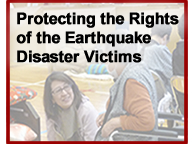[Media] Kazuko Ito, Secretary General of HRN, appeared on the NHK program "Point of View, Point of Issue" on May 23rd speaking on the topic of improving the situation of women victims of the Tohoku-Kanto earthquake
On May 23rd, Kazuko Ito, Secretary General of HRN, appeared on the program "Point of View, Point of Issue" on NHK Educational TV and spoke widely on the problems of improving the situation of women victims of the Tohoku-Kanto Earthquake.
Air date: May 23, 2011
Air time: 12:50 p.m. - 1 p.m. (ten minutes)
NHK Educational TV, "Point of View, Point of Issue"
"Living in Shelters, Improving Women's Living Standards"
Improving the situation of women affected by the recent natural disaster in Japan
Many precious lives have been lost in the East Japan earthquake, and many people have been forced to live in shelters. They cannot be certain about their futures. I would like to express our heartfelt condolences to the victims. HRN has visited damaged areas and listened to victims about their situations, especially regarding human rights issues such as access to food, clothing and shelter, and the situation of victims particularly vulnerable to disasters. I have provided legal consultation for victims and have listened to them about their serious losses.
In the past two months following the earthquake, victim fatigue and stress has gotten worse. We are especially concerned about the situation of people particularly vulnerable to disasters such as children, women, the disabled, foreigners and the aged. I will talk about the situation of women today.
The Gender Equality Bureau Cabinet Office published a document on March 16th entitled "Reacting to disasters based on the needs of women and child-care" which stressed the importance of care to women in running shelters. It proposed the following: 1. Creating partitions to protect women's privacy; 2. Constructing dressing rooms, nursing rooms and bathing facilities where women are sheltered from worrying about men's gazes; 3. Providing safe restrooms separated according to sex; 4. Understanding the needs of women at the scene of the disaster; 5. Participation of women in the management of shelters; 6. Consulting with women's doctors and other relevant consultants on women's needs. Each point addresses important concerns for women, and they are drawn from past disasters, such as the Great Hanshin Earthquake in Kobe. It is important that they be realized. However, the problem is whether or not they are implemented in shelters.
HRN has researched the situation of women in three stricken prefectures and found that there are serious gaps between the contents of the Cabinet Office's report and reality.
・Many shelters do not have partitions to separate families from one another, and they cannot protect people's privacy. In some shelters there are not even dressing rooms or nursing rooms for women, and women are forced to change clothes on their futon.
・Some restrooms are not safe. Temporary restrooms constructed outside have no lights, so women and young girls cannot use them safely.
・Due to shortages in laundry facilities and a lack of spaces to dry underwear safely, women cannot easily wash their underwear and have been forced to wear them once and throw them away. In spite of these conditions, women's underwear has not been sufficiently supplied, causing trouble for women.
・Many shelters are run by men, and few women are involved in the management of shelters.
・Women's legitimate pleas are reportedly often rejected by the men managing shelters on grounds such as that partitions are not good for shelters because they prevent the unification of community, and that goods for women, such as skin-lotion and underwear, are extravagances.
・At some shelters, local governments only supply ingredients, and evacuees must prepare food by themselves. At some of these shelters, the rules are such that only women are allotted cooking duties. Women are uniquely required to work, raise their children, and cook from morning until evening, and many women have become fatigued as a result.
・There are not enough counselors' offices where women can ask for advice. Few shelters prepare for counselors for women. More than a few shelters reject the offer of women's counseling by private institutions by saying that there is no spare time to do such a thing. They also reject the distributions of pamphlets that inform women of counseling by phone. It was reported that violence against women increased after the Great Hanshin Earthquake and natural disasters in foreign countries. However, despite this, the methods for preventing and responding to violence against women and protecting victims following the recent Tohoku-Kanto Earthquake have been insufficient.
Women who have lost their homes and families have been forced into silence because they fear worsening human relations at the shelters. However, the mere fact that women have been silent does not mean that there are no demands. It is necessary for outside people to understand women's demands, speak for them and improve their situation.
Because of the concern of reports being drawn into pie-in-the-sky illusions, central and local governments need to focus on the actual situation on the ground and improving conditions for women.
In light of this, the Cabinet Office has researched the situation at shelters on the ground, publishing its results on May 2nd.
http://www.cao.go.jp/shien/2-shien/6-zentyosa/3-result-3th.pdf
According to this report, in 182 shelters people do not have spare or enough underwear because they cannot wash them. In 108 shelters there are no partitions. However, the Cabinet Office was only able to examine the actual conditions in only 55% of shelters (92.6% in Iwate prefecture, 35.2% in Miyagi prefecture and 28.6% in Fukushima prefecture). The conditions in shelters which did not respond to its questions might be even worse.
For example, the report notes that food conditions have improved for many shelters. However, NPO and other relief volunteers have claimed that in reality the low nutritional value of foods has endangered pregnant women, children and persons with sickness. There is huge gap between the government's perception and reality.
The government and prefectures need to research the actual situation in shelters and react to problems quickly and fully, such as by strengthening the protection of women and by sending more public officers to local governments. Especially given that women may have difficulties voicing their opinions, they should listen carefully to women's demands and try to improve their situations.
It is also fundamentally necessary, when rushing to provide victims with quick temporary housing or rented private housing, to ensure their safe living. I met many people at the shelters, in particular many older women, who insisted that they could not apply for temporary housing because if they moved there, nobody would give them food or living supplies and they could not survive. Given the enormous damage caused and its challenge for full restoration, it is necessary for the government to continue supplying fundamental support and basic goods, such as food, even for victims who have moved from shelters into temporary housing.
Following the Great Hanshin Earthquake at Kobe, there were many earthquake-related deaths involving elderly people dying alone in temporary housing. It is a human rights concern that remains to be resolved. The government is responsible for protecting the human rights of victims as guaranteed in the Japanese Constitution. It must not happen again that earthquake victims' rights are not protected by the government.
It is not enough that the only persons involved in the discussions and meetings for the restoration plan at the time of its formation were experts and financiers. It is also necessary to sufficiently guarantee the participation in the process of those put most at risk by its decisions, people whose voices and demands cannot be otherwise heard. Moreover, insofar as women are inhabitants of the affected areas and carry important roles in the community, it is necessary for women to participate in the restoration process and have their perspectives sufficiently utilized.







